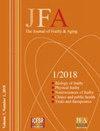Frailty among Older Adults and Its Distribution in England
IF 3.3
Q2 GERIATRICS & GERONTOLOGY
引用次数: 11
Abstract
Information on the spatial distribution of the frail population is crucial to inform service planning in health and social care. To estimate small-area frailty prevalence among older adults using survey data. To assess whether prevalence differs between urban, rural, coastal and inland areas of England. Using data from the English Longitudinal Study of Ageing (ELSA), ordinal logistic regression was used to predict the probability of frailty, according to age, sex and area deprivation. Probabilities were applied to demographic and economic information in 2020 population projections to estimate the district-level prevalence of frailty. The prevalence of frailty in adults aged 50+ (2020) in England was estimated to be 8.1 [95% CI 7.3–8.8]%. We found substantial geographic variation, with the prevalence of frailty varying by a factor of 4.0 [3.5–4.4] between the most and least frail areas. A higher prevalence of frailty was found for urban than rural areas, and coastal than inland areas. There are widespread geographic inequalities in healthy ageing in England, with older people in urban and coastal areas disproportionately frail relative to those in rural and inland areas. Interventions aimed at reducing inequalities in healthy ageing should be targeted at urban and coastal areas, where the greatest benefit may be achieved.英国老年人体质衰弱及其分布
关于体弱人口空间分布的信息对保健和社会保健方面的服务规划至关重要。利用调查数据估计老年人的小区域虚弱患病率。评估英格兰城市、农村、沿海和内陆地区的患病率是否存在差异。使用来自英国老龄化纵向研究(ELSA)的数据,根据年龄、性别和区域剥夺,使用有序逻辑回归来预测脆弱的概率。将概率应用于2020年人口预测中的人口和经济信息,以估计地区一级的脆弱性患病率。英国50岁以上成年人(2020年)的虚弱患病率估计为8.1 [95% CI 7.3-8.8]%。我们发现了很大的地理差异,在最脆弱和最脆弱的地区之间,脆弱的患病率变化了4.0[3.5-4.4]。城市地区比农村地区、沿海地区比内陆地区的虚弱患病率更高。在健康老龄化方面,英格兰存在着广泛的地域不平等,城市和沿海地区的老年人与农村和内陆地区的老年人相比,身体虚弱得不成比例。旨在减少健康老龄化方面不平等现象的干预措施应以城市和沿海地区为目标,因为在这些地区可以获得最大的利益。
本文章由计算机程序翻译,如有差异,请以英文原文为准。
求助全文
约1分钟内获得全文
求助全文
来源期刊

Journal of Frailty & Aging
GERIATRICS & GERONTOLOGY-
CiteScore
5.90
自引率
7.70%
发文量
54
期刊介绍:
The Journal of Frailty & Aging is a peer-reviewed international journal aimed at presenting articles that are related to research in the area of aging and age-related (sub)clinical conditions. In particular, the journal publishes high-quality papers describing and discussing social, biological, and clinical features underlying the onset and development of frailty in older persons. The Journal of Frailty & Aging is composed by five different sections: - Biology of frailty and aging In this section, the journal presents reports from preclinical studies and experiences focused at identifying, describing, and understanding the subclinical pathophysiological mechanisms at the basis of frailty and aging. - Physical frailty and age-related body composition modifications Studies exploring the physical and functional components of frailty are contained in this section. Moreover, since body composition plays a major role in determining physical frailty and, at the same time, represents the most evident feature of the aging process, special attention is given to studies focused on sarcopenia and obesity at older age. - Neurosciences of frailty and aging The section presents results from studies exploring the cognitive and neurological aspects of frailty and age-related conditions. In particular, papers on neurodegenerative conditions of advanced age are welcomed. - Frailty and aging in clinical practice and public health This journal’s section is devoted at presenting studies on clinical issues of frailty and age-related conditions. This multidisciplinary section particularly welcomes reports from clinicians coming from different backgrounds and specialties dealing with the heterogeneous clinical manifestations of advanced age. Moreover, this part of the journal also contains reports on frailty- and age-related social and public health issues. - Clinical trials and therapeutics This final section contains all the manuscripts presenting data on (pharmacological and non-pharmacological) interventions aimed at preventing, delaying, or treating frailty and age-related conditions.The Journal of Frailty & Aging is a quarterly publication of original papers, review articles, case reports, controversies, letters to the Editor, and book reviews. Manuscripts will be evaluated by the editorial staff and, if suitable, by expert reviewers assigned by the editors. The journal particularly welcomes papers by researchers from different backgrounds and specialities who may want to share their views and experiences on the common themes of frailty and aging.The abstracting and indexing of the Journal of Frailty & Aging is covered by MEDLINE (approval by the National Library of Medicine in February 2016).
 求助内容:
求助内容: 应助结果提醒方式:
应助结果提醒方式:


